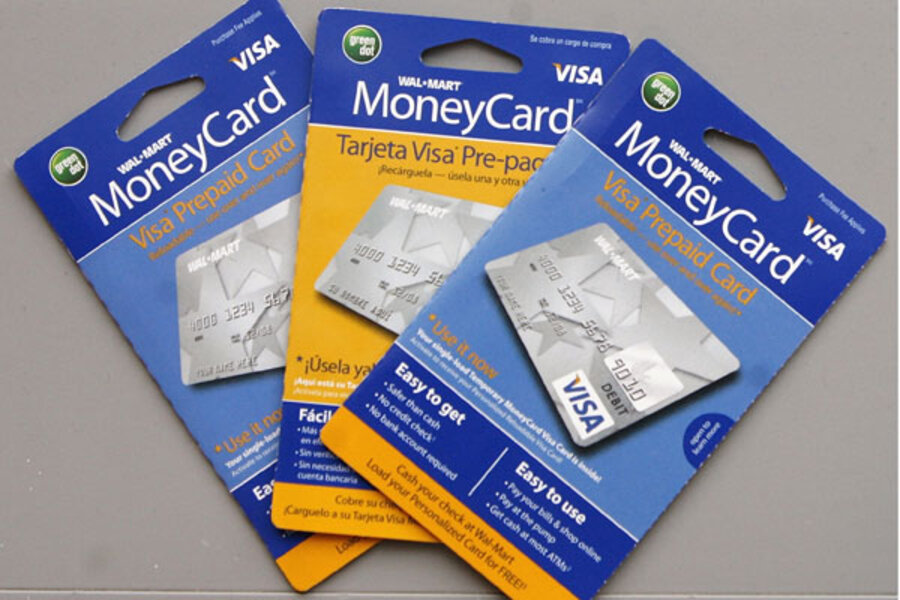Prepaid cards are here to stay. Do you need one?
Loading...
There’s an odd phenomenon going on right now: US consumers continue to rack up credit card debt at record rates ($50 billion this year for the second consecutive year), yet the fastest-growing financial product is a card that pays your bills without credit. Prepaid cards are a kind of anti-credit card, which you should find out about and decide whether one would be useful for your financial situation.
The surge in prepaid cards can be traced to Oct. 1, 2011. That is when the Federal Reserve began capping the fees that large banks can charge merchants when debit cards are used as payment in their stores. Faced with annual revenue losses of more than $8 billion, banks decided to deemphasize debit cards (and the checking accounts that go with them) and push the prepaid card instead.
It’s a natural alternative. You load money onto a prepaid card, through direct deposit of your check or, say, at the grocery store, then use that card to make purchases, pay monthly bills, and withdraw cash from automated teller machines (ATMs).
We’ve seen checking account fees rise, debit card rewards programs cut, new prepaid cards launched, and others emphasized with the aid of celebrity endorsers. That’s all helped fuel projections that consumers will load $117 billion onto prepaid cards in 2013 – a 200 percent increase since 2010.
Consumers are using them in at least three different ways. One of the main roles is as an alternative checking account. Prepaid cards are also well suited to be alternative check cashing tools for the roughly 17 million US adults who are unbanked, according to the Federal Deposit Insurance Corp., since some of them allow you to both load funds via check and make cash withdrawals for free. Finally, prepaid cards can be useful in teaching young people how to manage their money responsibly, since they allow kids to practice budgeting, using ATMs, and making purchases with plastic in a low-risk environment.
Not every prepaid card is well-suited for each of these applications. Different features will be needed, depending on the types of transactions you plan on making most, and you’ll be more at risk for certain fees as opposed to others. Here are some of the best prepaid cards, as identified in Card Hub’s 2012 Prepaid Cards Study.
Best for alternative checking: The GreenDot Gold Prepaid Visa is the best alternative checking account because it allows you to directly deposit your paycheck, make ATM withdrawals at GreenDot’s more than 22,000 locations nationwide, pay monthly bills, and make purchases all for free. You just have to make sure to directly deposit at least $1,000 per month or there will be a $5.95 fee.
Best check cashing tool: The Chase Liquid Prepaid Card is the best to use for check cashing because it’s tied into Chase’s banking network and charges a low monthly fee. For $4.95, you can load as many paychecks and other payments onto your card and make as many withdrawals as you wish.
Best for teaching financial literacy: The Approved Card from Suze Orman is the best teaching tool because as long as parents load at least $20 per month from a bank account, their kids won’t be charged for making withdrawals at AllPoint’s nationwide network of 43,000 ATMs. The only fees that will likely come into play are a $3 activation fee and a $3 monthly fee.
As long as the Fed keeps capping fees for swiping a debit card at a retail outlet, prepaid cards are here to stay. Banks are also investing heavily in prepaid cards these days, and they’ll want to make sure they recoup their investment.
That said, not everyone needs a prepaid card. If your checking account has low fees, you have no teens at home, and you don’t use check-cashing services every month, you probably don’t need one. If any of those conditions apply, consider getting a prepaid card that meets your needs.
– Odysseas Papadimitriou is chief executive officer of Card Hub, a leading online marketplace for comparing prepaid debit cards and credit cards, and Wallet Hub, a new personal finance social network.







